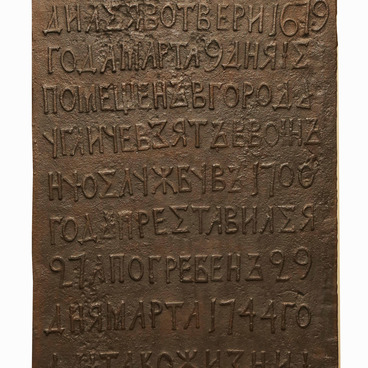The men’s hunting belt with a scabbard dates back to the late 19th and early 20th century. Such a belt decorated with metal plates in the form of plaques is called a belt with plates.
#5
Hunting belt with a scabbard
#6
#12
The belt is made of leather. There are three rows of metal plaques on its outer side. The item is decorated with copper pendants and chains that hang freely and intertwine. Wooden sheaths with a copper cover in the form of narrow ribbons are attached to the chains on their right side. On the left, there is a leather pouch with a knife grinder. The middle part of the belt is decorated with an openwork buckle. Holes are on one side of the buckle, while a hook-like protrusion is on the other. The hook caught on the holes and the belt could be fastened.
#8
This accouterment item was popular among the people who lived in the northern part of the Urals. It was worn for hunting and during festive celebrations and military fights. The hunting belt was a sign of the man’s virtues.
Its appearance comes from the ancient times when metal elements on leather garments served as armor. For the Khanty and Mansi peoples, such a belt was the only decoration in men’s attire.
#10
Belt elements
#7
This element of dress appeared at the beginning of a new era. Belts with plates were made of a single strip of elk, horse or cow skin. Sometimes the indigenous peoples of the North used a buckskin called rovduga as a material for the belt.
#9
In the late 19th — early 20th centuries, metal plaques for belts with plates worn by the people of Western Siberia were made by craftsmen among the settled population of the Komi people. These people lived in villages and were engaged in cattle breeding and crop farming. This lifestyle allowed them to pass on craft traditions from generation to generation. Craftsmen created molded openwork cover plates and plaques that were used as decorative elements of both belts with plates and other elements of folk costumes by the Khanty, Mansi and the Komi reindeer herding people.
#4
Metal plaques were produced in sand molds using a clay or wooden pattern. This is one of the oldest metal casting techniques. The caster used a pattern and created a casting mold of the molding sand, which was then filled with molten metal. The finished mold was melted in a furnace in a special graphite boiler. The Komi people used supplied Russian metal that consisted of various bronze alloys, cast iron and bronze. The molding sand differed in composition depending on the region, culture, and even the caster. Plaque manufacturers kept this composition secret. For the Komi people, the main material for the molding sand was chernozem, sand and clay mixed with burnt manure. After the product was removed, the sand mold was destroyed, and the caster needed a new one to produce another plate.
#13
Using
#11
A belt with plates was worn over men’s outerwear. Various items were attached to its front side, which might be needed for hunting or in a battle, including a knife in a scabbard, a dagger, a stone to sharpen the knife, a flintstone and a grindstone. Combined decorative elements of a belt could say a lot about its owner. The belt was required to be worn by all men, except for the elderly and children.
#14
O.E. Kler Sverdlovsk Regional Ethnography Museum
читать дальшескрыть
00:00
00:00
1x
Hunting belt with a scabbard
Время создания
Late 19th – early 20th centuries
2
Открыть в приложении
Поделиться

